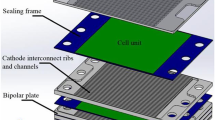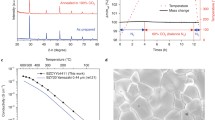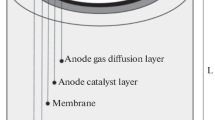Abstract
The principal objective of the present work is to realize thermodynamic modeling and analysis of the Proton Ceramic Fuel Cell (PCFC); particular attention is given to evaluate and optimize the power density generated by PCFCs according to the electrolyte, anode, and cathode thicknesses, water content in the oxidant and fuel, operating temperature, current density, and voltage. To implement the thermodynamic model, the PCFC voltage is represented by the difference between the Nernst potential and the total voltage loss generated in the electrolyte and electrodes (ohmic, activation, and concentration overpotentials) during PCFC operation. A FORTRAN program is developed to study the impact of these parameters on PCFC power density. After comparing the obtained results in this investigation to those of literature that are measured experimentally, they are presented a good concordance with root mean square error (RMSE) and mean bias error of 0.0572 and 0.0058, respectively. The conducted optimization, in this work, is realized based on the graphical method. The most important conclusions are summed in two points, PCFC power density is proportional to the operating temperature, and it is inversely proportional to the electrolyte and electrodes thicknesses and fuel and air humidification.





Similar content being viewed by others
References
Dai, H.; Kou, H.; Wang, H.; Bi, L.: Electrochemical performance of protonic ceramic fuel cells with stable BaZrO3-based electrolyte: a mini-review. Electrochem. Commun. 96, 11–15 (2018)
Zeng, S.M.; Parbey, J.; Yu, G.S.; Xua, M.; Li, T.S.; Andersson, M.: Thermal stress analysis of sulfur deactivated solid oxide fuel cells. J. Power Sour. 379, 134–143 (2018)
Sahli, Y.; Zitouni, B.; Ben-Moussa, H.: Thermodynamic optimization of the solid oxyde fuel cell electric power. Univ. Politehnica Bucharest Sci. Bull. Ser. B Chem. Mater. Sci. 80, 159–170 (2018)
Iwahara, H.; Esaka, T.; Uchida, H.; Maeda, N.: Proton conduction in sintered oxides and its application to steam electrolysis for hydrogen production. Solid State Ion. 3–4, 359–363 (1981)
Iwahara, H.; Uchida, H.; Maeda, N.: High temperature fuel and steam electrolysis cells using proton conductive solid electrolytes. J. Power Sour. 7, 293–301 (1982)
Prakash, B.S.; Pavitra, R.; Kumar, S.S.; Aruna, S.T.: Electrolyte bi-layering strategy to improve the performance of an intermediate temperature solid oxide fuel cell: a review. J. Power Sour. 381, 136–155 (2018)
Fabbri, E.; Bi, L.; Pergolesi, D.; Traversa, E.: Towards the next generation of solid oxide fuel cells operating below 600 °C with chemically stable proton-conducting electrolytes. Adv. Mater. 24, 195–208 (2012)
An, H.; Lee, H.W.; Kim, B.K., et al.: A 5 × 5 cm2 protonic ceramic fuel cell with a power density of 1.3 W cm–2 at 600 °C. Nat. Energy 3, 870–875 (2018)
Antunes, I.; Pérez-Coll, D.; Nasani, N., et al.: Mechanochemical processing of BaZr1−yYyO3−δ (y = 0.15, 0.20) protonic ceramic electrolytes: phase purity, microstructure, electrical properties and comparison with other preparation routes. Int. J. Hydrog. Energy 46, 13606–13621 (2021). https://doi.org/10.1016/j.ijhydene.2020.06.222
Ma, Y.; Huang, J.; He, B.: Scalable fabrication process for new structure BaZr0.8Y0.2O3-δ-based protonic ceramic fuel cells. Ceram. Int. 47, 14680–14688 (2021). https://doi.org/10.1016/j.ceramint.2021.01.264
Wang, R.; Lau, G.Y.; Ding, D.; Zhu, T.; Tucker, M.C.: Approaches for co-sintering metal-supported proton-conducting solid oxide cells with Ba(Zr, Ce, Y, Yb)O3-d electrolyte. Int. J. Hydrog. Energy 44, 13768–13776 (2019)
Pers, P.; Mao, V.; Taillades, M.; Taillades, G.: Electrochemical behavior and performances of Ni-BaZr0.1Ce0.7Y0.1Yb0.1O3-δ cermet anodes for protonic ceramic fuel cell. Int. J. Hydrog. Energy 43, 2402–2409 (2018)
Nasani, N.; Ramasamy, D.; Brandão, A.D.; Yaremchenko, A.A.; Fagg, D.P.: The impact of porosity, pH2 and pH2O on the polarisation resistance of Ni–BaZr0.85Y0.15O3−δ cermet anodes for protonic ceramic fuel cells (PCFCs). Int. J. Hydrog. Energy 39, 21231–21241 (2014)
Shin, E.-K.; Anggia, E.; Parveen, A.S.; Park, J.-S.: Optimization of the protonic ceramic composition in composite electrodes for high-performance protonic ceramic fuel cells. Int. J. Hydrog. Energy 44, 31323–31332 (2019)
Cui, J.; Wang, J.; Zhang, X.; Li, G.; Wu, K.; Cheng, Y.; Zhou, J.: Low thermal expansion material Bi0.5Ba0.5FeO3-δ in application for proton-conducting ceramic fuel cells cathode. Int. J. Hydrog. Energy 44, 21127–21135 (2019)
Lee, H.; Lee, S.; Lee, T.; Park, S.; Shin, D.: Long term stability of porosity gradient composite cathode controlled by electro-static slurry spray deposition. Int. J. Hydrog. Energy 42, 3748–3752 (2017)
Zhang, L.; Yang, S.; Zhang, S.; Yang, Y.: Cerium and Gadolinium co-doped perovskite oxide for a protonic ceramic fuel cell cathode. Int. J. Hydrog. Energy 44, 27921–27929 (2019)
Loureiro, F.J.A.; Ramasamy, D.; Mikhalev, S.M., et al.: La4Ni3O10±δ – BaCe0.9Y0.1O3-δ cathodes for proton ceramic fuel cells; short-circuiting analysis using BaCe0.9Y0.1O3-δ symmetric cells. Int. J. Hydrog. Energy 46, 13594–13605 (2021). https://doi.org/10.1016/j.ijhydene.2020.06.243
Wang, R.; Sun, Z.; Choi, J.P.; Basu, S.N.; Stevenson, J.W.; Tucker, M.C.: Ferritic stainless steel interconnects for protonic ceramic electrochemical cell stacks: oxidation behavior and protective coatings. Int. J. Hydrog. Energy 44, 25297–25309 (2019)
Gao, J.; Meng, Y.; Hong, T.; Kim, S.; Lee, S.; He, K.; Brinkman, K.S.: Rational anode design for protonic ceramic fuel cells by a one-step phase inversion method. J. Power Sour. 418, 162–166 (2019)
Zamfirescu, C.; Dincer, I.: Thermodynamic performance analysis and optimization of a SOFC-H+ system. Thermochim. Acta 486, 32–40 (2009)
Li, K.; Araki, T.; Kawamura, T.; Ota, A.; Okuyama, Y.: Numerical analysis of current efficiency distributions in a protonic ceramic fuel cell using Nernst-Planck-Poisson model. Int. J. Hydrog. Energy 45, 34139–34149 (2020). https://doi.org/10.1016/j.ijhydene.2020.09.143
Zhang, Q.; Guo, Y.; Ding, J.; Jiang, G.: New approaches for the determination of electrochemical parameters in the model of proton-conducting solid oxide fuel cell. Electrochim. Acta 318, 560–571 (2019)
Patcharavorachot, Y.; Arpornwichanop, A.: Investigation of a proton-conducting SOFC with internal autothermal reforming of methane. Comput. Aided Chem. Eng. 30, 307–311 (2012). https://doi.org/10.1016/B978-0-444-59519-5.50062-9
Sahli, Y.; Mohammedi, A.; Tamerabet, M.; Ben-Moussa, H.: Optimization study of the produced electric power by PCFCs. In: Khellaf, A. (Ed.) Advances in renewable hydrogen and other sustainable energy carriers. Springer, Singapore (2021). https://doi.org/10.1007/978-981-15-6595-3_26
Menon, V.; Banerjee, A.; Dailly, J.; Deutschmann, O.: Numerical analysis of mass and heat transport in proton-conducting SOFCs with direct internal reforming. Appl. Energy 149, 161–175 (2015)
Kalinci, Y.; Dincer, I.: Analysis and performance assessment of NH3 and H2 fed SOFC with proton-conducting electrolyte. Int. J. Hydrog. Energy 43, 5795–5807 (2018)
Zhang, Q.; Guo, Y.; Ding, J.; Xia, S.: Hole conductivity in the electrolyte of proton-conducting SOFC: mathematical model and experimental investigation. J. Alloys Compd. 801, 343–351 (2019)
Sahli, Y.; Zitouni, B.; Ben-Moussa, H.: Solid oxide fuel cell thermodynamic study. Çankaya Univ. J. Sci. Eng. 14, 134–151 (2017)
Arpornwichanop, A.; Patcharavorachot, Y.; Assabumrungrat, S.: Analysis of a proton-conducting SOFC with direct internal reforming. Chem. Eng. Sci. 65, 581–589 (2010)
Arpornwichanop, A.; Patcharavorachot, Y.: Investigation of a proton-conducting SOFC with internal autothermal reforming of methane. Chem. Eng. Res. Des. 91, 1508–1516 (2013)
Zhang, J.-H.; Lei, L.-B.; Liu, Di.; Zhao, F.-Y.; Ni, M.; Chen, F.: Mathematical modeling of a proton-conducting solid oxide fuel cell with current leakage. J. Power Sour. 400, 333–340 (2018)
Zheng, K.-Q.; Ni, M.; Sun, Q.; Shen, L.-Y.: Mathematical analysis of SOFC based on co-ionic conducting electrolyte. Acta Mech. Sin. 29, 388–394 (2013)
Bavarian, M.; Soroush, M.: Mathematical modeling and steady-state analysis of a proton-conducting solid oxide fuel cell. J. Process Control 22, 1521–1530 (2012)
Patcharavorachot, Y.; Brandon, N.P.; Paengjuntuek, W.; Assabumrungrat, S.; Arpornwichanop, A.: Analysis of planar solid oxide fuel cells based on proton-conducting electrolyte. Solid State Ion. 181, 1568–1576 (2010)
Ferguson, J.R.; Fiard, J.M.; Herbin, R.: Three-dimensional numerical simulation for various geometries of solid oxide fuel cells. J. Power Sour. 58, 109–122 (1996)
Bao, C.; Cai, N.; Croiset, E.: A multi-level simulation platform of natural gas internal reforming solid oxide fuel cell–gas turbine hybrid generation system – Part II. Balancing units model library and system simulation. J. Power Sour. 196, 8424–8434 (2011)
Youcef, S.; Bariza, Z.; Houcine, M.; Hocine, B.-M.: Three-dimensional numerical study of the anode supported intermediate temperature solid oxide fuel cell overheating. Int. J. Heat Technol. 37, 1099–1106 (2019)
Sahli, Y.; Ben-Moussa, H.; Zitouni, B.: Optimization study of the produced electric power by SOFCs. Int. J. Hydrog. Energy 44, 22445–22454 (2019)
Cheng, T.C.; Huang, T.Y.; Chen, C.F., et al.: Analysis of an intermediate-temperature proton-conducting SOFC hybrid system. Int. J. Green Energy 13, 1640–1647 (2016)
Ni, M.; Leung, M.K.H.; Leung, D.Y.C.: Mathematical modelling of proton-conducting solid oxide fuel cells and comparison with oxygen-ion-conducting counterpart. Fuel Cells 07, 269–278 (2007)
Potter, A.R.; Baker, R.T.: Impedance studies on Pt|SrCe0.95Yb0.05O3|Pt under dried and humidified air, argon and hydrogen. Solid State Ion. 177, 1917–1924 (2006)
Author information
Authors and Affiliations
Corresponding author
Ethics declarations
Conflict of interest
The author declares that they have no known competing financial interests or personal relationships that could have appeared to influence the work reported in this paper.
Rights and permissions
About this article
Cite this article
Sahli, Y. Thermodynamic Modeling and Analysis of Proton Ceramic Fuel Cells: Power Optimization. Arab J Sci Eng 47, 6355–6363 (2022). https://doi.org/10.1007/s13369-021-06262-7
Received:
Accepted:
Published:
Issue Date:
DOI: https://doi.org/10.1007/s13369-021-06262-7




